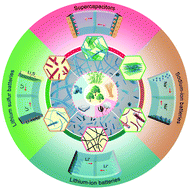Nanocellulose: a promising nanomaterial for advanced electrochemical energy storage
Abstract
Nanocellulose has emerged as a sustainable and promising nanomaterial owing to its unique structures, superb properties, and natural abundance. Here, we present a comprehensive review of the current research activities that center on the development of nanocellulose for advanced electrochemical energy storage. We begin with a brief introduction of the structural features of cellulose nanofibers within the cell walls of cellulose resources. We then focus on a variety of processes that have been explored to fabricate nanocellulose with various structures and surface chemical properties. Next, we highlight a number of energy storage systems that utilize nanocellulose-derived materials, including supercapacitors, lithium-ion batteries, lithium–sulfur batteries, and sodium-ion batteries. In this section, the main focus is on the integration of nanocellulose with other active materials, developing films/aerogel as flexible substrates, and the pyrolyzation of nanocellulose to carbon materials and their functionalization by activation, heteroatom-doping, and hybridization with other active materials. Finally, we present our perspectives on several issues that need further exploration in this active research field in the future.



 Please wait while we load your content...
Please wait while we load your content...